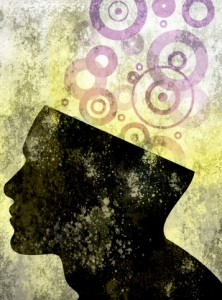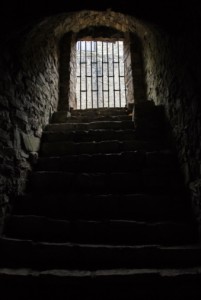Ken Wilber: Theories of Consciousness (Part Three)
By Asher Crispe: April 15, 2011: Category Inspirations, Thought Figures
 As explained in the previous article, connecting the four letters of the Divine name has another important commonality with integral thinking. There are ten principle names for Divinity that relate to different dimensions of reality or channels of creation. The name that is both a particular one of the ten as well as the one that unites and signifies the essence of the ten, is the Tetragrammaton (yud, hei, vav and hei).
As explained in the previous article, connecting the four letters of the Divine name has another important commonality with integral thinking. There are ten principle names for Divinity that relate to different dimensions of reality or channels of creation. The name that is both a particular one of the ten as well as the one that unites and signifies the essence of the ten, is the Tetragrammaton (yud, hei, vav and hei).
Furthermore, this name corresponds to the idea of tiferet or beauty. More specifically tiferet relates to the aesthetic of blended and enmeshed reality such that there is interinclusion of whole and part, part and whole. Tiferet is an integral property. Consequently, the four fold aspects of this name are illustrative of an integral relationship that when complete produces a unified consciousness and a holistic sense of reality.
An excellent example of four quadrant thinking in a Torah context would be the basic collection of exoteric and esoteric interpretations of the exodus story commemorated every year during the Jewish holiday of Passover.
Surface readings of the exodus narrative would seem to reflect a historical record of events that at face value took place in the past in a specific geographical location under unique social, cultural, political and spiritual circumstances. This treatment of the exodus from Egypt as an objective event, discreet and self-contained, only resonates within a single quadrant of the fourfold model we have previously described.
In Wilber’s terminology, we would be speaking about something that happened in a singular fashion (a one-time event) on an exterior plane of reality. Here we would have to treat the objectivity of the event as something only related to itself even though it is decidedly ‘collective’ in that it affects an entire people. Thus, we are already seeing the categories overlap. To evaluate the exodus as an interobjective reality would already necessitate explaining it in relation to the large system of history, society, politics and spirituality. How does it interconnect with a more extensive set of objective experiences?
In Kabbalah and Chassidic philosophy, the other quadrants immediately come into play.
Starting with the Talmudic directive that requires a person to see himself or herself as having left Egypt every single day, the kabbalists decode a level of meaning that is both timeless and deeply personal. Each of us has our own private Egypt. This becomes easier to understand when considering the Hebrew term for Egypt which is mitzrayim comes from the word maitzerim meaning “limitation” or “confinement”.
Taken this way, Egypt ceases to be merely a world-historical destination on a conventional map. At the level of subjective truth, of that which relates to each of us as individuals within our inner experience, there is a psycho-spiritual frame of consciousness known as Egypt or mitzrayim. To be enslaved in this context amounts to feeling trapped within oneself due to subjective limitations.
The weight of our subjectivity, the pull of the ego, can leave a person feeling riveted to oneself. It is as if to say ‘I can’t get beyond myself because my sense of self and ego keep getting in the way and holding me back.’ On this level, going out of Egypt would means transcending personal limits, escaping egology or the understanding and interpretation of everything in terms of my own self-interests. Certainly, this solipsistic mode of being needs to be overcome each day. Moving past the prison of self-reference towards the other, the outside, the unknown is an ongoing challenge.
Along the same lines, the Chassidic masters see the construction and somewhat ‘artificial’ confinement of an individual within the orbit of self as a direct result of our embodiment. We are a soul in a body, an incorporated self. The nature of the body— without the aid of special equipment such as a microscope to prove that it is indeed porous—carries the pretense of being a sealed capsule. Locked in our closed containers, no ‘out of body’ experience is possible. Our view of the world is always a limited view from somewhere—a ‘somewhere’ oriented in the body. All of our perception is situated by virtue of the body. Consequently, the body itself is the Egypt of the subject or the limitation of the subjective.
Turning to Wilber’s lower left quadrant, we encounter the collective subjective experience. Here we are addressing social exile and limitation. As a society we can look at the limitations which bind us collectivity and hinder the positive transformation of society. The exodus on this level would entail the emergence of a free society. “We” need to be redeemed. This is no longer just about my personal redemption. Ultimately the inner spirit is uplifted as a collective exodus which affects the liberation the people.
 The collective identity of the Jewish people was forged as a result of having been extracted from Egypt. Thus, we might even suggest that, by extension, our entire social world may transcend its limitations beginning with the recognition that we impose these restrictions on ourselves. We are both the inmates and the jailers. Kabbalistic sources play upon this idea by casting our positive social inclinations as Israelite, while our negative one’s are dramatized as Egyptian. The self-same actors play a dual role. In this manner we may hopefully come to realize that society needs to improve each day. Every day we may escape the initial negative conditions of the world and elevate the world and all of its inhabitants to the uncharted territory of unprecedented possibilities.
The collective identity of the Jewish people was forged as a result of having been extracted from Egypt. Thus, we might even suggest that, by extension, our entire social world may transcend its limitations beginning with the recognition that we impose these restrictions on ourselves. We are both the inmates and the jailers. Kabbalistic sources play upon this idea by casting our positive social inclinations as Israelite, while our negative one’s are dramatized as Egyptian. The self-same actors play a dual role. In this manner we may hopefully come to realize that society needs to improve each day. Every day we may escape the initial negative conditions of the world and elevate the world and all of its inhabitants to the uncharted territory of unprecedented possibilities.
What of the remaining quadrant—the realm of the interobjective? How can we network an understanding of the exodus with other real world phenomena? To accomplish this we must begin by reconfiguring the process of going beyond limitations and escaping confinement in terms of empirical objects in a system. Systems theory, in particular, sees no freestanding objects but rather a meshed world wherein each element affects and is affected by all of the others.
In terms of ‘objective observables,’ we might put forth the idea that objective phenomena are not only linked at a single scale but are also interrelated in a subtler fashion across different scales. In other words, the exodus story may be taken as an archetype which re-inscribes itself at every level of reality. This is to say, that if we have a universally relevant model of breaking beyond our psychological and sociological limitations, that it must also apply to our material limits as well.
Contemporary science has been moving in the direction of articulating radically new materialisms for some time. Once thought to be merely passive and determinate, matter, with its propensity for ‘self-assembly’ on a molecular level, yields some surprising results now that it is depicted as part of an integrated physical system. These new materialisms afford us the opportunity to comprehend, to some degree, the idea of Divine intervention that in turn helps us to pass over or beyond our physical, objective limits. For instance, the biological limits of cell reproduction and tissue regeneration must be overcome. And in fact, this is exactly what has started occurring within contemporary bio-medical research. What yesterday seemed like a physical limit of our biology has now been challenged and even transcended with the advent of new technologies.
Therefore, the condition of accomplishing more and more than ever before, which has become the hallmark of technology, reminds us of the exodus. Each new level or benchmark that we achieve is considered expansive and liberating when compared with the previous level. However, even this new level, in comparison with the next level above that, will turn into its own relative state of limitation and confinement.
Thus, the interobjective reading of going out of Egypt equates Egypt with the entire world, the whole interconnected tapestry of creation. The world, as it is presently constituted, is inherently limited when compared with the world to come—the next revised new and improved version of itself. The updated reality brought on by ongoing moment to moment innovations is a new found freedom when compared with its older constitution. Proceeding level by level allows us to greet each new opportunity as another replay of the exodus from Egypt or transcending of limits.
Now that we have assembled interpretations that relate to each of the four quadrants, we must continue to emphasize that all four categories must always be present and that they are all one. They complement each other and to that extent fill out a complete picture. It is not enough to say the exodus was merely in psycho-spiritual subjective event or that it was merely a one-time historical occurrence. All the levels of interpretation work together and hopefully enhance each other.
To recap:
Our subjective exile is the Egypt of the body and the confinement of self. The exodus therefore becomes a story of personal salvation or self-improvement.
Our collectively shared social experience is underscored by the limitations of society. Sociological revolutions entail a breaking out of intersubjective restrictions. Building a better world entails working our way up from a relatively lower Egypt-like state to the relative higher state of freedom.
 The historical account of a one-time event and our remembrance thereof would constitute a singular objective, empirical reality—the plain meaning of going out of Egypt. At this level, it is all about the history and geography of the original event.
The historical account of a one-time event and our remembrance thereof would constitute a singular objective, empirical reality—the plain meaning of going out of Egypt. At this level, it is all about the history and geography of the original event.
Finally, the model of transcending limits as a fundamental feature of the world, places the limits of creation in the position of being the relative ‘Egypt’ or limiting factor. Ascending from level to level, soliciting greater and greater performance from out of the natural world, surpasses the singular concept of a historical Passover and empirically demonstrates how the whole affair keeps happening over and over again throughout history and across all scales of empirical investigation.
Ken Wilber: Theories of Consciousness (Part Three) ,























;)
;)
;)
;)
;)
;)
;)
;)
;)
;)


I just simply want to say thank you for sharing your insight and look forward to your articles each week.